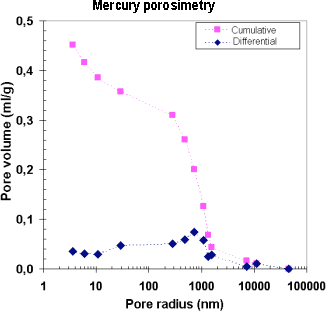Dispersed and porous materials, first of all catalysts, sorbents, supports.
Following parameters are defined:
1. The total material surface is defined by express method in the circulating unit by argon adsorption and more precise static methods by isotherms of low temperature adsorption of nitrogen, oxygen and other gases. Determination limits (the lower, the upper): for express methods – 0,01 and hundreds m2/g, for static ones – 1 and thousands m2/g.
The required quantity is defined as follows: not less than 0.5 m2 per sample weight for circulating method and 10–20 m2 per sample weight for static one.
2. The separate surface of the supported metals of the 8th group is determined by selective oxygen chemisorption, under circulating conditions by impulse dosing.
The required sample quantity is defined as follows:
not less than 1 m2 of active surface per sample weight.
3. Pore and surface size distribution are defined:

The measurements by nitrogen adsorption are conducted at 77 K on ASAP-2400 (Micromeritics, USA) and AutoSorb IV (Quantochrome, USA) devices.
Mercury-porosimetric studies are performed on the automatic porosimeters Micromeritics (USA) PoreSizer 9300
The required sample quantity is defined as follows:
not less than 10–15 m2 per sample weight.
4. Powder particle size distribution is defined by the laser diffraction method on Laser Diffraction particle size Analyzer SALD-2101 (Shimadzu, Japan). The results are presented as the integral and differential curves of particle number or weight portion distribution versus the size, estimation of the average size and total outer surface of particles.
5. Estimation of the true density is performed by gas pycnometry on Autopycnometer-1320 (Micrometrics, USA) with helium. For the optimal material volume (8–9 cm3) an accuracy of measurement is ± 0.02 cm3.
Samples in the form of powder, granules and fragments
with linear sizes not exceeding 30 mm.
The general requirement to the samples presenting for estimation of texture-geometric parameters indication by the customer of the admissible temperatures of sample heating in the course of preliminary testing.

Prof. V.B. Fenelonov. Mechanism of formation and simulation of the texture of catalysts and adsorbents, development of adsorption and mercury-porosimetric methods for porous structure study, applied adsorption. The author of monographs “Porous carbon” (1995) and “Introduction in physical chemistry of formation of supramolecular structur of adsobents and catalysts” (2002, 2004).
Prof. V.Yu. Gavrilov. Porous structure genesis for the difficulty crystallizing oxides of the IV group – SiO2, TiO2, SnO2 and ZrO2 as well as the binary systems on their basis.
Dr. M.S. Mel'gunov. Physics and chemistry of nanomaterials including mesoporous mesophase and carbon composites, synthesis and research.